Sunday, July 25, 2010
Wednesday, July 14, 2010

Red blood cells (also referred to as erythrocytes) are the most common type of blood cell and the vertebrate organism's principal means of delivering oxygen (O2) to the body tissues via the blood flow through the circulatory system. They take up oxygen in the lungs or gills and release it while squeezing through the body's capillaries.
These cells' cytoplasm is rich in hemoglobin, an iron-containing biomolecule that can bind oxygen and is responsible for the blood's red color.
In humans, mature red blood cells are flexible biconcave disks that lack a cell nucleus and most organelles. The cells develop in the bone marrow and circulate for about 100–120 days in the body before their components are recycled by macrophages. Each circulation takes about 20 seconds. Approximately a quarter of the cells in the human body are red blood cells.
Red blood cells are also known as RBCs, red blood corpuscles (an archaic term), haematids, erythroid cells or erythrocytes (from Greek erythros for "red" and kytos for "hollow", with cyte translated as "cell" in modern usage). The capitalized term Red Blood Cells is the proper name in the US for erythrocytes in storage solution used in transfusion medicine.
HYDROELECTRIC ENERGY

Hydroelectricity is electricity generated by hydropower, i.e., the production of electrical power through the use of the gravitational force of falling or flowing water. It is the most widely used form of renewable energy. Once a hydroelectric complex is constructed, the project produces no direct waste, and has a considerably lower output level of the greenhouse gas carbon dioxide (CO2) than fossil fuel powered energy plants. Worldwide, an installed capacity of 777 GWe supplied 2998 TWh of hydroelectricity in 2006. This was approximately 20% of the world's electricity, and accounted for about 88% of electricity from renewable sources.
CONSTELLATIONS

In colloquial usage, a constellation is a group of celestial bodies, usually stars, which appear to form a pattern in the sky. Astronomers today still utilize the term, though the current system focuses primarily on constellations as grid-like segments of the celestial sphere rather than as patterns. A star-pattern that is not officially classed as a constellation is referred to as an asterism. One famous example is the asterism known as the Big Dipper, a term unused by the International Astronomical Union (IAU) as the stars are considered part of the larger constellation of Ursa Major.
In 1922, Eugène Delporte aided the IAU in dividing the celestial sphere into 88 official constellations. Typically, these modern constellations share the names of their Graeco-Roman predecessors, such as Orion, Leo and Scorpius. While such celestial formations were originally linked to a mythical event, creature or person, the categorization of the night sky into recognizable patterns was important in early land and naval navigation prior to the invention of the compass during the Age of Discovery. With the technical advancement of astronomy, it became important to move from a pattern-based system of constellations to one based on area-mapping, which led to several historic formations becoming obsolete.
Thermometer

A thermometer (from the Greek θερμός (thermo) meaning "warm" and meter, "to measure") is a device that measures temperature or temperature gradient using a variety of different principles. A thermometer has two important elements: the temperature sensor (e.g. the bulb on a mercury thermometer) in which some physical change occurs with temperature, plus some means of converting this physical change into a value (e.g. the scale on a mercury thermometer). Thermometers increasingly use electronic means to provide a digital display or input to a computer

Biodiversity is the variation of life forms within a given ecosystem, biome, or on the entire Earth. Biodiversity is often used as a measure of the health of biological systems. The biodiversity found on Earth today consists of many millions of distinct biological species. The year 2010 has been declared as the International Year of Biodiversity.
Biodiversity is not distributed evenly on Earth, but is consistently rich in the tropics and in specific localized regions such as the Cape Floristic Province; it is less rich in polar regions where fewer species are found.
Rapid environmental modifications typically cause extinctions. Of all species that have existed on Earth, 99.9 percent are now extinct. Since life began on Earth, five major mass extinctions have led to large and sudden drops in the biodiversity of species. The Phanerozoic eon (the last 540 million years) marked a rapid growth in biodiversity in the Cambrian explosion—a period during which nearly every phylum of multicellular organisms first appeared. The next 400 million years was distinguished by periodic, massive losses of biodiversity classified as mass extinction events. The most recent, the Cretaceous–Tertiary extinction event, occurred 65 million years ago, and has attracted more attention than all others because it killed the nonavian dinosaurs.
Tuesday, July 13, 2010
invertebrates animals

Invertebrates are animals that belong to a large animal group. These animals do not belong to a single sub-phylum like the vertebrates. The invertebrates are those animals without a Invertebrates organisms and mostly form a colony of individual cell that function as one. All the cells in the colony have a particular function. They have no cell walls and many have tissues, except the sponges. Most of the invertebrates produce sexually. Most of the invertebrates can move about except the adult sponges. There are many invertebrates that follow symmetrical organization. This means one can draw a line down the middle of the animal and the two sides will be similar like mirror images. Invertebrates are heterotrops that feed on plants and animals. The invertebrates include the following animals: The vertebrates are grouped under sub-phylum Vertebrata. The vertebrates are animals that posses an internal skeleton, that is, endoskeleton. This endoskeltons is made up of a internal column of vertebrae. The sub phylum Vertebrata is grouped within the phylum Chordata. The vertebrates form the most advanced organisms on the planet. Vetebrates are larger than the invertebrates. Most of the vertebrates have an advanced nervous system, that makes them smarter. The other characteristics of vertebrates include a bilateral symmetry, body segmentation, complete digestive system, closed blood system, bony or cartilaginous endoskeleton, tail and ventral heart.


